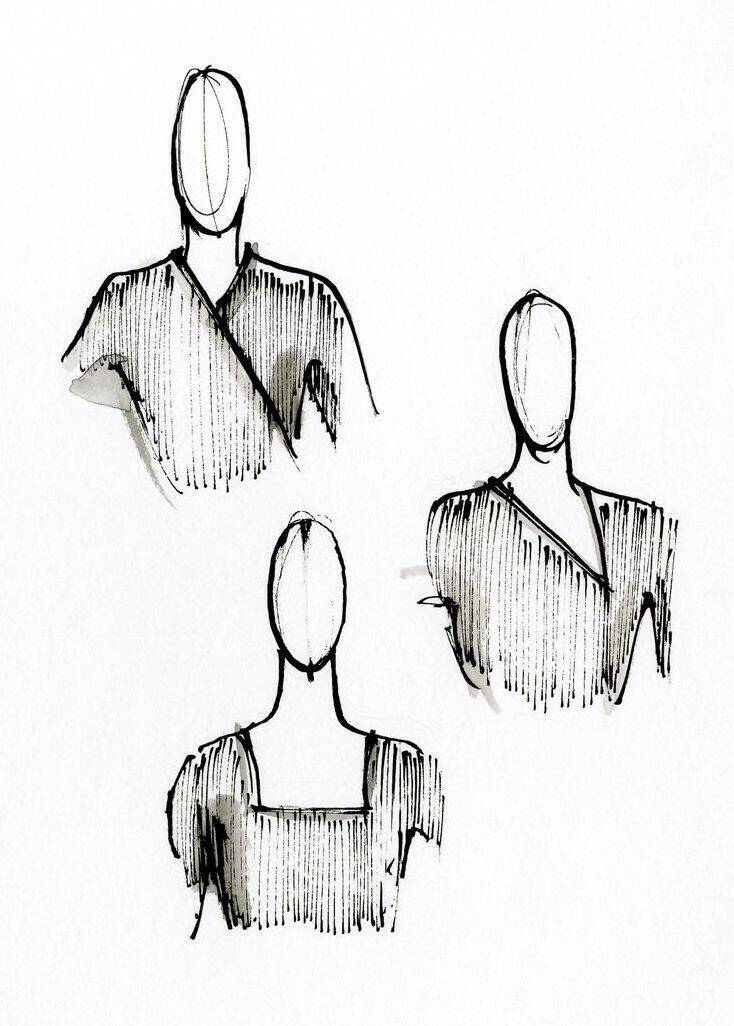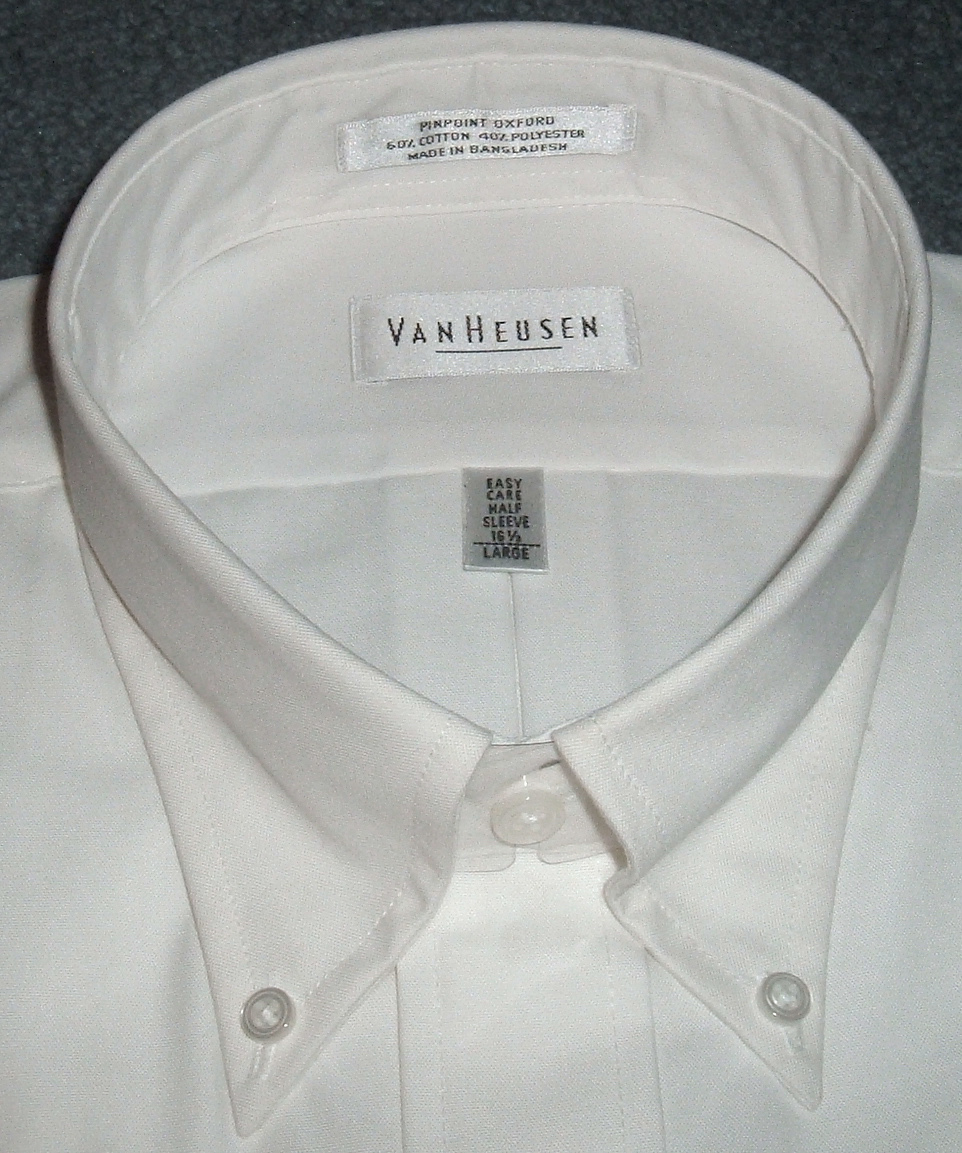|
Neckline
The neckline is the top edge or edges of a clothing, garment that surrounds the neck, especially from the front view. Neckline also refers to the overall visual line between all the layers of clothing and the neck and Shoulder, shoulders of a person, ignoring any unseen undergarments. For each garment worn above the waist, the neckline is primarily a style line and may be a boundary for further shaping of the upper edge of a garment with, for example, a Collar (clothing), collar, cowl neck, cowl, dart (sewing), darts, or pleats. In that respect it is similar to the waistline (clothing), waistline and hemline. Types Necklines can be grouped into categories according to their shape and where they cut across the body. Boat neck The boat neck, also called the ''bateau neckline'' or ''Sabrina neckline'', is a high, wide, slightly curved neckline that passes past the collabones and hangs on both shoulders. It has one edge and is nearly linear. One variation is the ''portrait nec ... [...More Info...] [...Related Items...] OR: [Wikipedia] [Google] [Baidu] |
Necklines
The neckline is the top edge or edges of a garment that surrounds the neck, especially from the front view. Neckline also refers to the overall visual line between all the layers of clothing and the neck and shoulders of a person, ignoring any unseen undergarments. For each garment worn above the waist, the neckline is primarily a style line and may be a boundary for further shaping of the upper edge of a garment with, for example, a collar, cowl, darts, or pleats. In that respect it is similar to the waistline and hemline. Types Necklines can be grouped into categories according to their shape and where they cut across the body. Boat neck The boat neck, also called the ''bateau neckline'' or ''Sabrina neckline'', is a high, wide, slightly curved neckline that passes past the collabones and hangs on both shoulders. It has one edge and is nearly linear. One variation is the ''portrait neckline''. Crew neck This neckline is circular and sits at the base of the throat. ... [...More Info...] [...Related Items...] OR: [Wikipedia] [Google] [Baidu] |
Cleavage (breasts)
Cleavage is the narrow depression or hollow between the breasts of a woman. The superior portion of cleavage may be accentuated by clothing such as a low-cut neckline that exposes the division, and often the term is used to describe the low neckline itself, instead of the term décolletage. Joseph Breen, head of the U.S. film industry's Production Code Administration, coined the term in its current meaning when evaluating the 1943 film '' The Outlaw'', starring Jane Russell. The term was explained in ''Time'' magazine on August 5, 1946. It is most commonly used in the parlance of Western female fashion to refer to necklines that reveal or emphasize ''décolletage'' (display of the upper breast area). The visible display of cleavage can provide erotic pleasure for those who are sexually attracted to women, though this does not occur in all cultures. Explanations for this effect have included evolutionary psychology and dissociation from breastfeeding. Since at least the 15th ... [...More Info...] [...Related Items...] OR: [Wikipedia] [Google] [Baidu] |
Cowl Neck
A cowl neck is a neckline consisting of a loose draped fabric collar. The term can describe the neckline of a wide variety of garments, from the draped neckline of an evening gown to a raised neckline of knitwear similar to a turtleneck. The neckline was introduced in the 1920s by Madeleine Vionnet based on her study of ancient Grecian sculptures. The style is named for the cowl, a feature of monastic dress that serves as both a collar and a hood. History 20th century Inspired by the draped garments of antiquity, Madeleine Vionnet created the cowl neckline in the 1920s using the bias cut technique that she helped to popularize. The cowl neck enjoyed the peak of its popularity in the 1930s. Cowl neck sweaters were popular in the 1970s. Dresses of the disco era also frequently had cowl necks. Cowl necklines were a common feature of slip dresses made in the 1990s by designers such as John Galliano. 21st century Two of the most notable garments of the early 2010s featured a cowl ... [...More Info...] [...Related Items...] OR: [Wikipedia] [Google] [Baidu] |
Collar (clothing)
In clothing, a collar is the part of a shirt, dress, coat or blouse that fastens around or frames the neck. Among clothing construction professionals, a collar is differentiated from other necklines such as revers and lapels, by being made from a separate piece of fabric, rather than a folded or cut part of the same piece of fabric used for the main body of the garment. A collar may be permanently attached to the main body of the garment (e.g. by stitching) or detachable. Word usage The Oxford English Dictionary traces ''collar'' in its modern meaning to c. 1300, when collars served as neck-protecting armour. History Today's shirt collars descend from the rectangular band of linen around the neck of 16th century shirts. Separate ruffs exist alongside attached ruffled collars from the mid-16th century, usually to allow starching and other fine finishing, or to make collar-laundering easier.Compare: During the medieval period and sporadically thereafter, people wore ... [...More Info...] [...Related Items...] OR: [Wikipedia] [Google] [Baidu] |
Boat Neck
A boat neck, also called a bateau neck or Sabrina (1954 film), Sabrina neckline, is a wide neckline that runs horizontally, front and back, almost to the shoulder points, across the collarbone. It is traditionally used in nautically inspired sweaters and knitwear, but is also featured in more elegant cocktail dresses and eveningwear. The style derives from French sailors' blouses, often with wide navy and white horizontal stripes. History A striped boat neck shirt was used in sailors' uniforms of the History of the French Navy, French Navy in 1858. The wide, plain neckline was said to facilitate quick removal if a sailor were to fall overboard. The style was adopted by the Russian Navy and other navies in the following years. It came into prominence in mainstream fashion in the 1920s and was popularised by Coco Chanel in the '30s. In the '50s and '60s, plain boat neck shirts were worn by artists associated with beatnik culture. Around that same period, Madame Nhu, Trần Lệ Xu ... [...More Info...] [...Related Items...] OR: [Wikipedia] [Google] [Baidu] |
T-shirt
A T-shirt (also spelled tee shirt, or tee for short) is a style of fabric shirt named after the T shape of its body and sleeves. Traditionally, it has short sleeves and a round neckline, known as a '' crew neck'', which lacks a collar. T-shirts are generally made of stretchy, light, and inexpensive fabric and are easy to clean. The T-shirt evolved from undergarments used in the 19th century and, in the mid-20th century, transitioned from undergarments to general-use casual clothing. T-shirts are typically made of cotton textile in a stockinette or jersey knit, which has a distinctively pliable texture compared to shirts made of woven cloth. Some modern versions have a body made from a continuously knitted tube, produced on a circular knitting machine, such that the torso has no side seams. The manufacture of T-shirts has become highly automated and may include cutting fabric with a laser or a water jet. T-shirts are inexpensive to produce and are often part of fast fashi ... [...More Info...] [...Related Items...] OR: [Wikipedia] [Google] [Baidu] |
Waistline (clothing)
The waistline is the line of demarcation between the upper and lower portions of a garment, which notionally corresponds to the natural waist but may vary with fashion from just below the bust to below the hips. The waistline of a garment is often used to accentuate different features. The waistline is also important as a boundary at which shaping darts (such as those over the bust and in the back) can be ended. Types of waistlines Similar to necklines, waistlines may be grouped by their shape, depth, and location of the body. * None: The princess seams style of dress needs no waistline at all, since it does its shaping without darts, by joining edges of different curvature. The resulting "princess seams" typically run vertically from the shoulder (or under the arm) over the bust point and down to the lower hem. This creates a long, slimming look, often seen in dresses with an " A-line" silhouette. * Diagonal: An asymmetrical waistline that runs across the body diagonally. Us ... [...More Info...] [...Related Items...] OR: [Wikipedia] [Google] [Baidu] |
Halterneck
Halterneck is a style of women's clothing strap that runs from the front of the garment around the back of the neck, generally leaving the upper back uncovered. The name comes from livestock halters. The word "halter" is of Germanic origin and means "holder" or "that which holds". The halter style is used with swimsuits, to maximize sun tan exposure on the back and minimize tan lines. It is also used with dresses or shirts, to create a backless dress or top. The neck strap can itself be covered by the wearer's hair, leaving the impression from behind that nothing is holding the dress or shirt up. If a bra is worn with a halter top, it is generally either strapless or of halterneck construction itself, to avoid exposing the back straps of a typical bra. A halter top is a type of sleeveless shirt similar to a tank top (by the American English definition) but with the straps being tied behind the neck. In another style of the halter top, there is only a narrow strap behind th ... [...More Info...] [...Related Items...] OR: [Wikipedia] [Google] [Baidu] |
Undergarments
Underwear, underclothing, or undergarments are items of clothing worn beneath outer clothes, usually in direct contact with the skin, although they may comprise more than a single layer. They serve to keep outer clothing from being soiled or damaged by bodily excretions, to lessen the friction of outerwear against the skin, to shape the body, and to provide concealment or support for parts of it. In cold weather, long underwear is sometimes worn to provide additional warmth. Special types of undergarments have religious significance. Some items of clothing are designed as undergarments, while others, such as T-shirts and certain types of shorts, are appropriate both as underwear and outerwear. If made of suitable material or textile, some underwear can serve as nightwear or swimwear, and some undergarments are intended for sexual attraction or visual appeal. Undergarments are generally of two types, those that are worn to cover the torso and those that are worn to cover t ... [...More Info...] [...Related Items...] OR: [Wikipedia] [Google] [Baidu] |
Hemline
The hemline is the line formed by the lower edge of a garment, such as a skirt, dress or coat, measured from the floor. The hemline is perhaps the most variable style line in fashion, changing shape and ranging in height from hip-high to floor-length. What is a fashionable style and height of hemline has varied considerably throughout the years, and has also depended on a number of factors such as the age of the wearer, the occasion for which the garment is worn and the choice of the individual. Types Similar to necklines and waistlines, hemlines can be grouped by their height and shape: * floor-length hemlines * ankle hemlines * midcalf hemlines * below-knee hemlines * above-knee hemlines * mid-thigh hemlines * hip-high hemlines * handkerchief hemlines * diagonal or asymmetric hemlines * high-low hemlines, usually short in front and dipping behind * other hemlines, such as modern-cut hemlines Dresses and skirts are also classified in terms of their length: * mini * ba ... [...More Info...] [...Related Items...] OR: [Wikipedia] [Google] [Baidu] |







